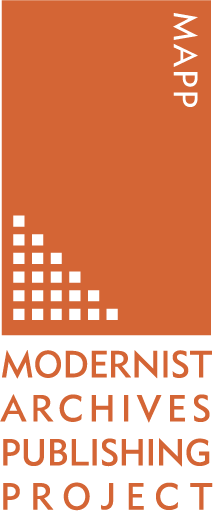Welcome to our August post from MAPP! I'll begin recursively, taking us back two months. June offered up one of the annual delights for us as Woolf scholars: the 25th Annual Virginia Woolf Conference organized by the supremely hospitable and well-organized Julie Vandivere and held this year at Bloomsburg University in Bloomsburg, Pennsylvania, a beautiful, quintessentially 'leafy-green' college campus in rural Pennsylvania where we felt warmly welcomed not only by the university, but also the entire town (never before has a downtown cinema welcomed conference goers by name and with Woolf's own inimitable visage in blinking bright lights). 206 speakers attended, from 5 continents, and 14 countries. 4 of the 6 MAPP team members (Alice, Elizabeth, Helen, and Nicola) were delighted to have the chance to meet in situ again after a year of Google Hang-Outs. Our first 'business' meeting actually took place on the 2-hour bus ride from Newark Airport, where along with 50+ garrulous Woolfians, we enjoyed the chance to catch up in person. Claire was at a Modernist Biography conference on Lake Cuomo but sent alluring images of the Alps, and Mike was back at Stanford working on his many projects for the university.
The theme of this year's conference was "Virginia Woolf and Her Female Contemporaries" and the poster itself was a revelation: a montage including what I like to call the "fur and diamond" Woolf from her 1925 portrait, positioned not at the centre, but at the edge of over 60 black and white photographs of the many other contemporary women writers in whose orbit Woolf wrote. Julie's partner had conceived the poster and the only criteria for inclusion was that the woman artist had to be the subject of a presentation. (And as any conference organizer will tell you, this mandate provided some consternation given the inevitable changes in scheduling and programming in the months-long run-up to the conference; but integrity held firm and -- we think -- in the final version all images found their audience.) Here is just a sample, representing the wide range of critical work presented: Katherine Mansfield; Vita Sackville-West; Laura Riding; Emma Goldman; Eudora Welty; Colette; Florence Riddell; Vera Brittain; Charlotte Perkins Gilman; Mary Sheepshanks; Marianne Moore; Ling Shuhua; Vanessa Bell; Mary Hutchinson; Bryher; Zitkala-Sa; Elizabeth Bowen; Simone Weil; Jean Rhys; Georiga O'Keefe; Rebecca West; May Sinclair; Lucy Maud Montgomery; Alice Meynell; Enid Bagnold; Ingeborg Bachmann; Dorothy Sayers...and on and on.
The theme allowed presenters to foreground other female modernists -- literally, to make them vocal and visible -- in order to complicate our ongoing theorizations around what Bonnie Kime Scott has rechristianed 'Gender In Modernism'. From the perspective of MAPP, it resonated with our collective efforts to push forward the (re)positioning of Woolf as integrally tied to networks of creative work, the embodied, human, laboring circuitry of artistic production that (perhaps ironically now) can get lost in 'Woolf, Canonical Modernist'. This push and pull surrounding Woolf's construction as the leading female modernist can, in some discourses, still, as Madelyn Detloff reminded us in her plenary, turn all too quickly into current accounts of modernism in which Woolf remains the only referenced (or taught) woman writer. It's like a game of "Quick! Name a Woman Modernist! Woolf! Phew. Next." Of course, no one in the Woolf community is tonedeaf to the paradoxes of this situation, given what enormous effort scholars of the 1970s and '80s undertook to establish Woolf as a writer of the highest caliber (read Elaine Showalter's memories of studying modernism at Brandeis University in the 1960s in her introduction to the 1992 Penguin edition of Mrs Dalloway if you want a piquant taste of that cultural time and climate). But what this represents is a generational turn, as Mark Hussey reminded us in his presentation on Rebecca West and Woolf, the very timeliness of a turn, in his estimation, to West, coinciding with and helping us reinvent the "New Modernist Studies" wherein networks, circuits of exchange, material conditions of production, national and transnational alliances and affiliations are all part of how the 'map' of modernism is changing. And broadening. And becoming, ideally, more complex. This is everything too that MAPP hopes to stand for intellectually and, in digital technological terms, to design for.
An innovative feature of the plenary format of the conference appears to have sprung from a desire for more colloquy and conversation, rather than podium pronouncement, in the keynote addresses. Every plenary hosted at least two scholars presenting separately and together on everything from biography and pyschoanalysis in Marianne Moore and HD (Susan McCabe and Linda Leavell) to theories of obscurity in modernism (Jane Garrity and MAPP's very own Helen Southworth!) to "big personality" modernist women writers (Melissa Bradshaw and Madelyn Detloff). There was a dynamic and highly informative Feminist Roundtable (Celia Marshik, Judith Brown, Emily Ridge, and Allison Pease) and a landmark session with Anne Fernald and Cassandra Laity where they announced the ambitious and exciting founding of a new journal, Feminist Modernist Studies, which they hope to launch in 2017 (coincidentally, but with some kismit, the centenary of The Hogarth Press).
We hope some of our readers will want to contribute to their efforts; check back with us for more links and news in forthcoming months!



